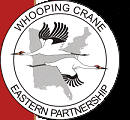Whooping Cranes on their way to Florida
Having just seen my first whoopers last week, I enjoyed receiving a press release from the U.S. Fish and Wildlife Service about the 20 cranes now migrating from Wisconsin to Florida. Here's the skinny.
 The birds entered Fentress County in Tennessee today while following five ultralight aircraft from Operation Migration. They left Necedah National Wildlife Refuge near Necedah, Wis., on Oct. 14 and began the 1,228-mile migration to Chassahowitzka NWR in Crystal River, Fla.
The birds entered Fentress County in Tennessee today while following five ultralight aircraft from Operation Migration. They left Necedah National Wildlife Refuge near Necedah, Wis., on Oct. 14 and began the 1,228-mile migration to Chassahowitzka NWR in Crystal River, Fla.
This is the fifth generation of the endangered species to fly to their winter home with human assistance. The chicks hatched at Patuxent Wildlife Research Center in Laurel, Md., and grew up away from humans but with ultralights. Operation Migration pilots as well as Patuxent and International Crane Foundation biologists conditioned the birds to fly for longer distances behind the aircraft.
Everyone who works with the chicks wears crane costumes and uses puppet heads to mimic adult bird behaviors. During the migration, the birds stay in temporary pens at stopover sites on private property volunteered by landowners. More than 35 landowners are participating in the current migration. Pretty cool what we humans will do for the benefit of birds, eh?
The 42 migratory birds in the East make up a small part of the 300 or so whoopers in the wild. Another migratory population nests at Wood Buffalo National Park in Canada's Northwest Territories and spends the winter at Aransas NWR near Austwell, Texas. A nonmigratory flock lives in central Florida.
 For daily updates by members of the migration team, visit the OM field journal. You'll find more details at Whooping Crane Eastern Partnership.
For daily updates by members of the migration team, visit the OM field journal. You'll find more details at Whooping Crane Eastern Partnership.
If projects like this warm your heart, please warm the project's coffers by donating funds.
 The birds entered Fentress County in Tennessee today while following five ultralight aircraft from Operation Migration. They left Necedah National Wildlife Refuge near Necedah, Wis., on Oct. 14 and began the 1,228-mile migration to Chassahowitzka NWR in Crystal River, Fla.
The birds entered Fentress County in Tennessee today while following five ultralight aircraft from Operation Migration. They left Necedah National Wildlife Refuge near Necedah, Wis., on Oct. 14 and began the 1,228-mile migration to Chassahowitzka NWR in Crystal River, Fla.This is the fifth generation of the endangered species to fly to their winter home with human assistance. The chicks hatched at Patuxent Wildlife Research Center in Laurel, Md., and grew up away from humans but with ultralights. Operation Migration pilots as well as Patuxent and International Crane Foundation biologists conditioned the birds to fly for longer distances behind the aircraft.
Everyone who works with the chicks wears crane costumes and uses puppet heads to mimic adult bird behaviors. During the migration, the birds stay in temporary pens at stopover sites on private property volunteered by landowners. More than 35 landowners are participating in the current migration. Pretty cool what we humans will do for the benefit of birds, eh?
The 42 migratory birds in the East make up a small part of the 300 or so whoopers in the wild. Another migratory population nests at Wood Buffalo National Park in Canada's Northwest Territories and spends the winter at Aransas NWR near Austwell, Texas. A nonmigratory flock lives in central Florida.
 For daily updates by members of the migration team, visit the OM field journal. You'll find more details at Whooping Crane Eastern Partnership.
For daily updates by members of the migration team, visit the OM field journal. You'll find more details at Whooping Crane Eastern Partnership. If projects like this warm your heart, please warm the project's coffers by donating funds.


0 Comments:
Post a Comment
<< Home